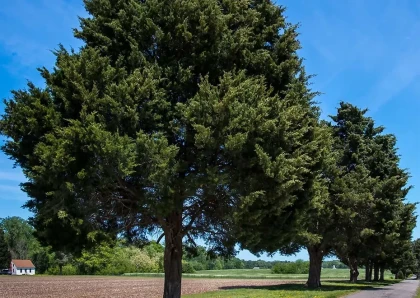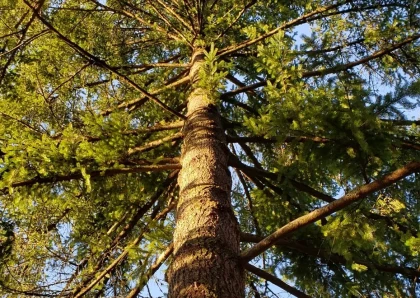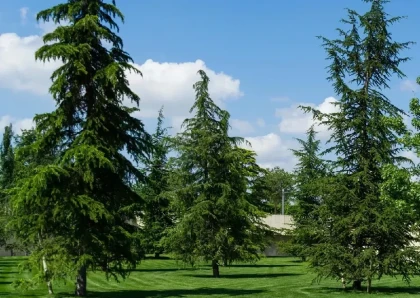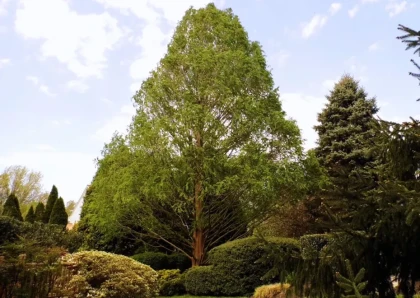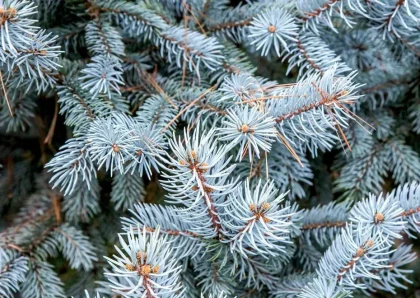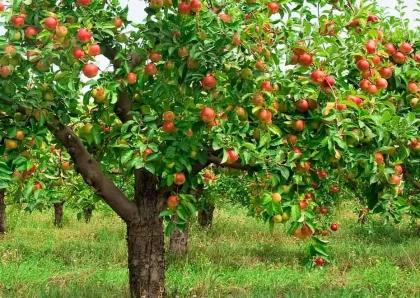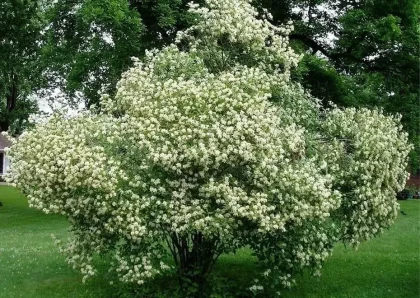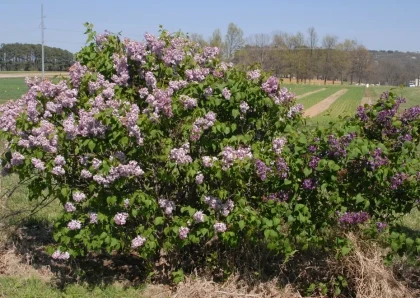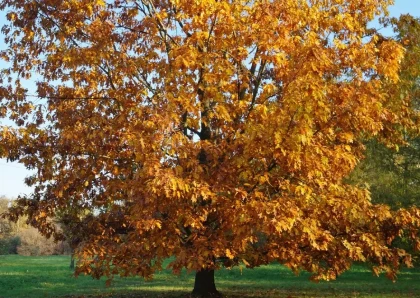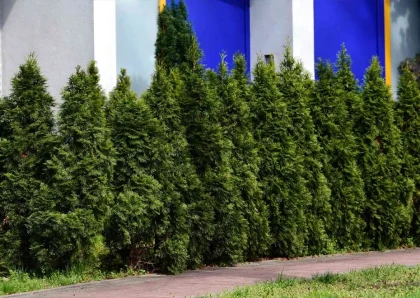
Black Hills Spruce Tree
Overview
Description
The Black Hills Spruce is an evergreen conifer with needles that are typically bluish-green in color and can grow to be quite tall, often reaching heights of 40 to 60 feet (12 to 18 meters). They are commonly used as ornamental trees in landscaping due to their attractive appearance and tolerance to cold temperatures. The Black Hills Spruce tree likely refers to a variety of spruce species that are native to the Black Hills area, such as Picea glauca var. densata (also known as the Black Hills White Spruce). This particular variety is a subspecies of the White Spruce (Picea glauca) and is well-adapted to the colder climate and higher elevations of the Black Hills. It appears to be a common name given to a type of spruce tree that is found in the Black Hills region of South Dakota, USA.
- Appearance: The Black Hills Spruce is an evergreen conifer with a pyramidal shape. It has dense branches that sweep upward and slightly droop at the tips. The needles are needle-like, stiff, and arranged spirally around the branches. The needles are typically bluish-green to silvery-blue in color, giving the tree a distinctive appearance.
- Size: These spruce trees can grow to be quite tall, reaching heights of 40 to 60 feet (12 to 18 meters) at maturity. The trunk diameter is generally around 1 to 2 feet (30 to 60 centimeters).
- Habitat: As the name suggests, the Black Hills Spruce is native to the Black Hills region of South Dakota, USA. The Black Hills is an area known for its rugged terrain, high elevations, and colder climate, and the tree is well-adapted to these conditions.
- Use: The Black Hills Spruce is valued for its ornamental qualities and is commonly used in landscaping and as a Christmas tree. Its attractive appearance, unique bluish-green color, and ability to tolerate colder temperatures make it a popular choice for decorating gardens, parks, and landscapes in areas with cold climates.
- Growing Conditions: This variety of spruce prefers well-drained soil and full sun. It is relatively low-maintenance once established and can tolerate a range of soil types. However, it thrives in cool, moist conditions and is well-suited to areas with cold winters.
- Conservation Status: The Black Hills Spruce is not listed as a threatened or endangered species. However, like all natural habitats, the Black Hills region faces conservation challenges, and it's essential to protect the native plants and animals that inhabit this unique ecosystem.
Different Types of Black Hills Spruce
- Colorado Blue Spruce (Picea pungens): While not native to the Black Hills, the Colorado Blue Spruce is often included in discussions about the region due to its similar bluish coloration. This spruce species is native to the Rocky Mountains but has been widely planted in the Black Hills and other areas for its striking appearance.
- Engelmann Spruce (Picea engelmannii): Another spruce species found in the Black Hills, the Engelmann Spruce has a more western distribution in North America. It has blue-green needles and is well-adapted to higher elevations and colder climates.
- Norway Spruce (Picea abies): The Norway Spruce is not native to the Black Hills but is often planted in the region as an ornamental tree. It has dark green needles and a more pendulous form compared to some of the other spruce species.
- White Spruce (Picea glauca): The White Spruce is the parent species of the Black Hills White Spruce (Picea glauca var. densata). While not exclusive to the Black Hills, the White Spruce is widespread across North America and is sometimes found in the region.
Wood Products made from Black Hills Spruce
- Lumber: Black Hills Spruce wood is commonly used for lumber in construction, furniture-making, and various woodworking projects. The wood is known for its light color, straight grain, and fine texture, making it suitable for interior applications.
- Plywood: The Black Hills Spruce can be processed into plywood, which is used for sheathing, flooring, and various other structural and decorative purposes.
- Pulp and Paper: The tree's wood fibers are used in the production of pulp and paper products, such as newsprint, writing paper, and cardboard.
- Musical Instruments: The high-quality resonance and tonal properties of Black Hills Spruce wood make it a popular choice for crafting soundboards in acoustic instruments like guitars, violins, and pianos.
- Christmas Trees: Due to its attractive appearance and conical shape, Black Hills Spruce trees are frequently grown and harvested as Christmas trees for holiday decorations.
- Utility Poles: The wood from Black Hills Spruce trees is used to manufacture utility poles, which are essential for supporting electrical and communication lines.
- Wood Chips: Black Hills Spruce wood is chipped and used in various applications, including mulch for landscaping, animal bedding, and as a source of biomass for energy production.
- Wood Crafts and Carvings: The fine texture and workability of Black Hills Spruce wood make it suitable for crafting small wooden items, sculptures, and intricate carvings.
Benefits of Planting Black Hills Spruce Tree
- Landscape Ornament: The Black Hills Spruce tree's attractive appearance, with bluish-green needles and a pyramidal shape, makes it a popular choice for landscaping and ornamental purposes in gardens, parks, and residential areas.
- Cold Climate Tolerance: Being native to the Black Hills region, the Black Hills Spruce is well-adapted to colder climates and can withstand harsh winter conditions, making it a hardy and resilient tree.
- Christmas Tree: The Black Hills Spruce is commonly used as a Christmas tree due to its conical shape and attractive foliage, making it a favorite choice for holiday decorations.
- Timber and Lumber: The wood of the Black Hills Spruce is used for timber and lumber in construction, furniture-making, and woodworking projects. Its light color, straight grain, and fine texture are valued attributes.
- Pulp and Paper Production: The wood fibers of the Black Hills Spruce are utilized in the production of pulp and paper products, including newsprint, writing paper, and cardboard.
- Instrument Making: The high-quality resonance and tonal properties of Black Hills Spruce wood make it a preferred material for crafting soundboards in musical instruments like guitars, violins, and pianos.
- Utility Poles: The Black Hills Spruce wood is employed in the construction of utility poles, serving as crucial supports for electrical and communication lines.
- Biomass and Wood Chips: The wood of the Black Hills Spruce is chipped and utilized as biomass for energy production, as well as for landscaping purposes like mulch and animal bedding.
- Wood Crafts and Carvings: The fine texture and workability of Black Hills Spruce wood make it suitable for crafting small wooden items, sculptures, and intricate carvings.
Tips for Planting and Maintaining Black Hills Spruce Tree
- Choose a Suitable Location: Select a planting site with full sun exposure and well-drained soil. Black Hills Spruce trees prefer slightly acidic to neutral soil pH levels.
- Plant at the Right Time: The best time to plant a Black Hills Spruce tree is in early spring or fall when the weather is cooler and there is sufficient moisture.
- Prepare the Planting Hole: Dig a hole that is twice as wide as the tree's root ball and of equal depth. Loosen the soil at the bottom of the hole to encourage root penetration.
- Watering: Keep the tree well-watered, especially during the first year after planting. Provide enough water to keep the soil consistently moist but not waterlogged.
- Mulch: Apply a layer of organic mulch around the base of the tree to retain soil moisture, suppress weeds, and protect the roots from temperature fluctuations.
- Pruning: Minimal pruning is typically required for Black Hills Spruce trees. Remove any dead, damaged, or diseased branches, and avoid heavy pruning to maintain the tree's natural shape.
- Fertilization: Black Hills Spruce trees generally do not require much fertilizer. If necessary, use a balanced fertilizer sparingly in the early spring.
- Protect from Deer: In areas with deer populations, consider protecting young trees from deer browsing with fencing or repellents.
- Winter Care: In colder climates, water the tree adequately before the ground freezes to ensure it has enough moisture during the winter months.
- Pest and Disease Management: Monitor the tree for any signs of pests or diseases and take appropriate action if necessary. Consult with local experts for guidance on pest control measures.
Cons of Planting Black Hills Spruce Tree
- Space Requirements: Black Hills Spruce trees can grow to be quite tall and wide, so they may not be suitable for small or confined spaces.
- Slow Growth: While the Black Hills Spruce is a long-lived tree, it has a slow growth rate, which means it may take many years to reach its full size.
- Need for Full Sun: Black Hills Spruce trees require full sun exposure to thrive. They may not perform well in shaded or partially shaded areas.
- Soil and pH Requirements: The tree prefers well-drained soil with slightly acidic to neutral pH levels. Unsuitable soil conditions may lead to poor growth or health issues.
- Drought Sensitivity: Black Hills Spruce trees can be sensitive to drought conditions, requiring consistent watering during dry periods.
- Pests and Diseases: While generally resilient, Black Hills Spruce trees can be susceptible to certain pests and diseases, such as spruce budworm, spruce needle rust, and canker diseases.
- Deer Browsing: In areas with deer populations, young Black Hills Spruce trees may be at risk of browsing damage, as deer find the tender foliage attractive.
- Seed Dispersal: The tree can produce cones and seeds that may disperse and result in unwanted seedlings if not managed properly.
- Litter and Needle Drop: Black Hills Spruce trees shed needles regularly, which may result in some litter and require periodic cleanup.
- Landscaping Considerations: Planting a Black Hills Spruce tree requires careful consideration of its mature size and location to avoid potential conflicts with structures, power lines, and neighboring properties.
Conclusion
The Black Hills Spruce tree (Picea glauca 'densata') is a valuable and versatile species with several notable attributes. Native to the Black Hills region of South Dakota, USA, this evergreen conifer boasts bluish-green needles, a pyramidal shape, and the ability to thrive in colder climates and higher elevations. Its attractive appearance makes it popular for landscaping and as a Christmas tree.
The Black Hills Spruce tree offers numerous benefits, such as providing lumber and plywood for construction and furniture-making, as well as wood chips and pulp for paper production. Its wood is highly regarded for crafting musical instruments due to its excellent resonance and tonal properties. Additionally, the tree plays a vital role in producing utility poles for electrical and communication lines.
However, there are some cons to consider when planting Black Hills Spruce trees. These include their space requirements, slow growth rate, sensitivity to drought, and potential susceptibility to pests and diseases. Proper site selection, maintenance, and pest management are crucial for ensuring the tree's health and longevity.
Overall, the Black Hills Spruce tree is a beautiful and valuable species, contributing to various industries and ecosystems while enhancing landscapes with its striking appearance. Responsible planting and maintenance practices can help preserve and benefit from the many qualities this tree has to offer.
FAQs
-
What is a Black Hills Spruce tree?
The Black Hills Spruce (Picea glauca 'densata') is a variety of spruce tree native to the Black Hills region of South Dakota, USA. It is known for its bluish-green needles and pyramidal shape, making it a popular choice for landscaping and as a Christmas tree.
-
What are the characteristics of the Black Hills Spruce tree?
The Black Hills Spruce tree has bluish-green needles that are stiff and arranged spirally around the branches. It has a pyramidal shape with dense branches that sweep upward and slightly droop at the tips. The tree can grow to be quite tall, reaching heights of 40 to 60 feet (12 to 18 meters).
-
Where is the Black Hills Spruce tree found?
The Black Hills Spruce tree is native to the Black Hills region of South Dakota, USA. It is well-adapted to colder climates and higher elevations in this area.
-
What are the uses of the Black Hills Spruce tree?
The Black Hills Spruce tree has various uses, including:
- Landscaping and ornamental purposes
- Christmas tree decorations
- Lumber and plywood for construction and furniture-making
- Pulp and paper production
- Instrument making, such as soundboards for guitars and pianos
- Utility poles for supporting electrical and communication lines
- Wood chips for landscaping and biomass energy
- Wood crafts and carvings
-
How do I plant a Black Hills Spruce tree?
Planting a Black Hills Spruce tree involves selecting a suitable location with full sun exposure and well-drained soil. The best time for planting is in early spring or fall. Dig a hole that is twice as wide as the root ball and of equal depth. After planting, provide regular watering, especially during the first year, and apply mulch around the base to retain soil moisture and suppress weeds.
-
What are the maintenance requirements for a Black Hills Spruce tree?
To maintain a Black Hills Spruce tree, consider the following:
- Watering regularly, especially during dry periods
- Minimal pruning to remove dead or diseased branches
- Fertilization, if necessary, with a balanced fertilizer in early spring
- Protecting young trees from deer browsing in areas with deer populations
- Monitoring for pests and diseases and taking appropriate action if necessary
-
What are the cons of planting a Black Hills Spruce tree?
Some potential drawbacks of planting a Black Hills Spruce tree include its space requirements, slow growth rate, need for full sun, sensitivity to drought, potential susceptibility to pests and diseases, deer browsing, seed dispersal, litter and needle drop, and landscaping considerations for its mature size.




